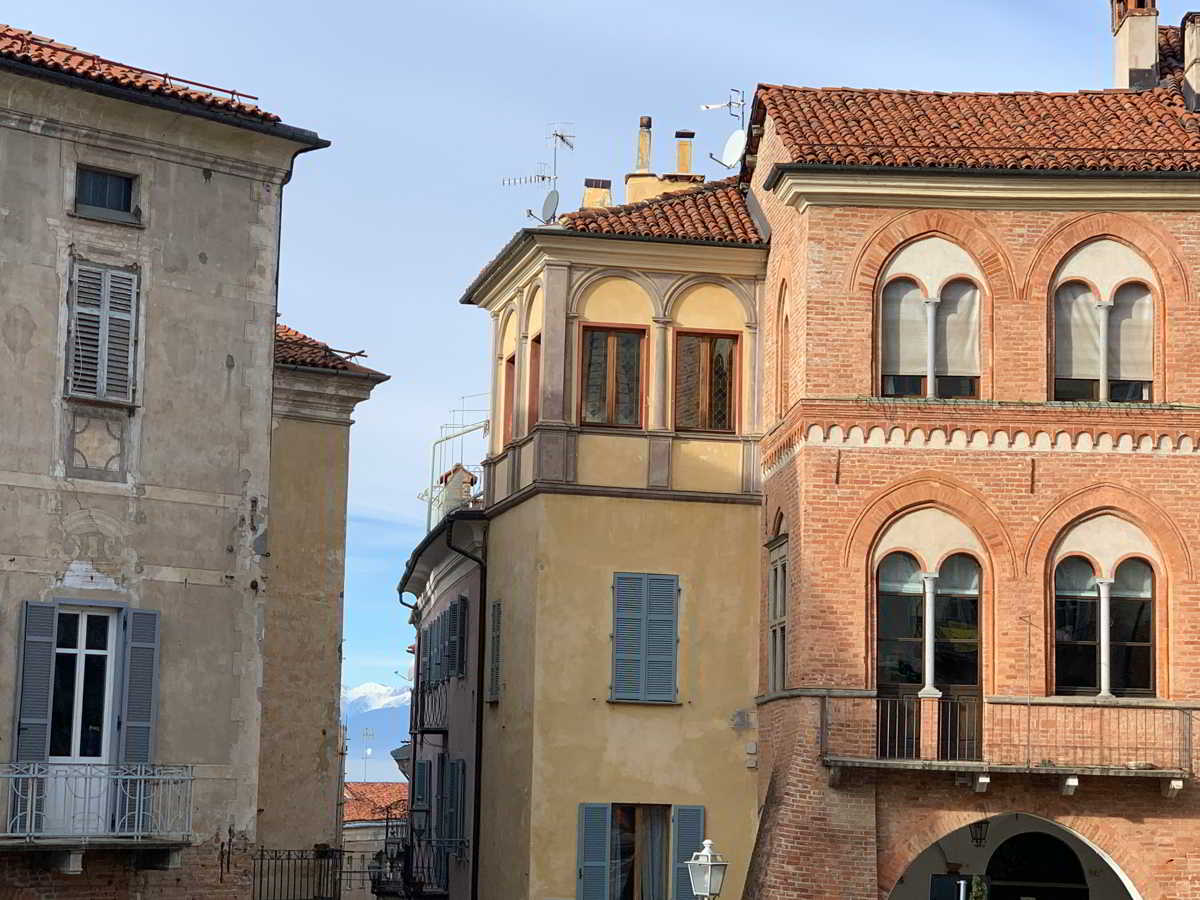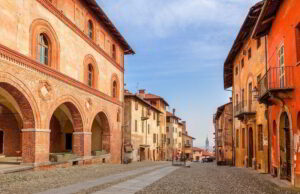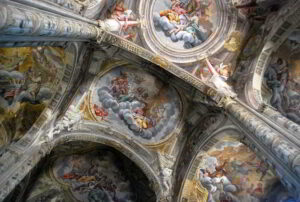MONDOVI’
Exploring the Town of Mondovì, and the Monregalese Hills in a Piedmont Tour
One of the highlights of a Piedmont tour is the town of Mondovì and the surrounding territory of the Monregalese Hills in Italy’s northwest corner.
Located at the foot of the southern Alps, where the Piedmont and Liguria regions meet, Mondovì is a small town built on two levels. Three different settlements merged into one fortified town.
Once a battlefield of the House of Savoy, due to the strategic trade and military position, this part of Piedmont preserves a rich legacy of Baroque architecture dating to the XVII and XVIII centuries, mainly connected to the work of local architect Francesco Gallo.
The surrounding territory of the town of Mondovì is home to another Piedmont must-see, the Shrine of Vicoforte, boasting the largest elliptical dome ever built in bricks. Other highlights include the Church of San Fiorenzo and several countryside chapels whose interiors were decorated with medieval fresco cycles.
Mondovì offers a glimpse into Italy’s captivating past and a journey into a fascinating territory rich in hidden treasures, legends, and less-known works of art worth visiting.
Mondovì Origins and Historical Highlights
The origins of Mondovì date back to the Roman Empire, but it truly flourished during the Middle Ages. Its strategic position at the intersection of trade routes crossing the mountain between Piedmont and the Mediterranean coast made it a vital settlement for commerce and military endeavors.
The surrounding territory is named in modern Italian “Monregalese” from the toponym “Mons Regalis” of the Old Town’s upland.
Mondovì Piazza is the old part of the city, founded around 1198 by the inhabitants of three hamlets—Vico, Vasco, and Carassone—who joined their forces and rebelled against the threats of local rulers.
This explains the town name Mondovì, which comes from “Mount of Vico,” the community’s first name.
In fact, the town has often been a battleground since the establishment of the diocese of Mondovì in 1388, when this part of Piedmont was taken away to the bishop of Asti.
Later, the House of Savoy left an indelible mark on its character and architecture. They recognized the town’s strategic importance in its development, fortifying its walls and constructing significant buildings that still stand today.
The town became a center of governance and culture, with an early seat of the university. Starting in the XIX century, the mass production of ceramics shaped the local economy and strongly impacted the town’s social life for about a century.
A Tour of Mondovì Breo
A tour of Mondovì begins from the lower town, known as Breo, which developed along the Ellero River.
Here, the church of Saint Peter and Saint Paul deserves a stop to look at the façade’s clock, whose mechanism is decorated with the shape of a local character named “Il Moro,” a popular character during carnival celebrations.
A second stop in the Breo neighborhood is the Baroque church of San Filippo, the first of several religious buildings designed by local architect Francesco Gallo.
The upper section of Mondovì, called Piazza, is connected by a modern and efficient funicular designed by Italian master Giorgetto Giugiaro.
Highlights of Mondovì Piazza
As one wanders through Mondovì, the remnants of its past are palpable. The ancient architecture, particularly in the upper town, narrates stories of a bygone era.
The Piazza Maggiore is the central square, built on an incline. It boasts beautiful porticoed palazzi embellished with frescoes, such as Palazzo dei Bressani, dating back to the XIII century, the Governor Palace, and many others.
The majestic San Francesco Church is a testament to the town’s historical prosperity. The juxtaposition of medieval and Baroque styles creates an enchanting atmosphere, inviting visitors to step back and appreciate the artistry and craftsmanship that define this remarkable location.
The Bishop’s Palace of Mondovì is known for its precious tapestries and the historic Sala delle Lauree. Between 1556 and 1719, the University of Mondovì was founded in this room. The ancient University, with its geographic location and other cultural events, made Mondovì one of the most important towns during the dukedom of the Savoy.
In 1472, for instance, in Mondovì came the first book printed in Piedmont with modern typography, just sixteen years after the printing work of the Gutenberg Bible.
Among the hidden gems of Piedmont and northern Italy stands Mondovì’s Printing Museum.
The works of art of local architect Francesco Gallo are spread across town. He was the man who brought the Baroque style to southern Piedmont. Walking around Mondovì Piazza, for instance, one can enter the Cathedral of S. Donato and the Misericordia Church that he designed.
Things to do in Mondovì: la Missione Church
The Church of S. Francesco Saverio, known as La Missione is on the side the central Piazza Maggiore of Mondovì, in Italy.
Built by architect Boetto in the XVII century for the Jesuits, it was decorated by Andrea Pozzo, a well-known artist who worked in Rome and Wien. The painter designed a fake architecture on the inner vault of the ceiling, giving the optical illusion of a much lighter and more expansive space.
Next to the church stands the former Jesuit residence, the first to be opened in Piedmont in 1561, as suggested by Emanuele Filiberto, Duke of Savoy.
Today, the site is home to the Palace of Justice, on whose outside walls were painted an astronomical observatory with twelve sun clocks. This work dates back to 1716 and was used by painter Gian Battista Rocca.
Mondovì Ceramic Museum and Other Things to See
Mondovì, in Italy, was once a major production center of ceramics. Since the early 1800s, in fact, this territory developed a distinctive decoration style used by local artisans who soon left room for industrial operations, which lasted until the 1950s.
The local Ceramic museum is an interesting addition to a Piedmont tour before continuing to explore the upper Mondovì Piazza.
From admiring the exterior of the 1700s Synagogue, the next stop is the so-called Parco del Tempo. This outdoor space displays several sundials and other instruments used to measure time.
Most installations are around the Civic Tower, from which one can enjoy views over the western Alps, the Matterhorn, and Piedmont.
Mondovì is also a major gathering point for air balloon festivals and the open-air Parco del Tempo is a perfect spot to see them flying.

Art on the Monregalese Hills around Mondovì
Mondovì serves as the starting point for one or more days of exploring the surrounding area, the Monregalese Hills.
Art lovers should not miss the Santa Croce chapel, located just outside the town center of Mondovì. Inside, it features ancient frescoes from the 1400s and a rare example of the brachial cross, a unique form of iconography from the Middle Ages. This artwork is attributed to Jacquerio, a prominent painter of that time who worked throughout Piedmont.
Artists traveled between Piedmont, France, and the Mediterranean Coast, leaving several works of art scattered across the modern province of Cuneo.
Another must-see on a Piedmont tour is the small church of San Fiorenzo in the town of Bastia di Mondovì. Its 326 square meters (3,509 square feet) of frescoes, dating back to the 15th century, are an outstanding masterpiece of “biblia pauperum,” used to educate illiterate pilgrims about the stories of the Bible.
Different masters completed this fresco cycle, as the church served as a point of reference for merchants, pilgrims, and soldiers traveling between Piedmont and Liguria across the mountains.
Vicoforte, a Piedmont’s Must-See
Mondovì’s central location in Piedmont makes it an excellent base for day trips to explore the surrounding areas. One of the most popular excursions is a visit to the stunning Shrine of Vicoforte, just a short drive or hike from the town.
From Mondovi’s Santa Croce chapel, a countryside road departs dotted with five votive buildings, although the original project included thirteen chapels conceived for pilgrims who could stop and pray along the way. The scenic 4 km (2.5 mi) hike takes about one hour from Mondovì to the Shrine of Vicoforte, surrounded by lovely views over the hills and the Alps.
Once in Vicoforte, the monumental church is renowned for its massive elliptical dome, the largest of its kind built in brick. The intricate details of the façade and the breathtaking artwork make it a must-see in a Piedmont tour for the spirituality and artistry of this remarkable site.
The idea of such a massive structure was of architect Francesco Gallo who used the previous foundation built by Ascanio Vitozzi centuries earlier.
The dome is part of a Sanctuary commissioned by Carlo Emanuele I, Duke of Savoy, as the family mausoleum.
Recently, the arrival in Vicoforte of the remains of King Vittorio Emanuele III and Queen Elena made the news arrival in Vicoforte of the remains of King Vittorio Emanuele III and Queen Elena.

Day Trips from Mondovì
Another enticing day trip is to the picturesque village of Ceva, between the Alta Langa region and the Apennines Mountains. Known for its stunning landscapes, Ceva offers a more rural experience, perfect for those seeking tranquility and natural beauty. Ceva’s charming streets, dotted with quaint shops and cafés, provide a delightful backdrop for leisurely walks and exploration.
A day trip to Alba is highly recommended to taste the region’s culinary delights. Known as the capital of the Langhe wine region, Alba is famous for its truffles and fine wines. The bustling markets, particularly during the truffle season, offer an array of local produce and delicacies. Visitors can indulge in wine tastings and sample traditional Piedmontese dishes in the many trattorias scattered throughout the town. The rich flavors and culinary heritage of Alba provide an unforgettable experience for food lovers, making it a perfect complement to a visit to Mondovì.
For a truly off-the-beaten-path experience, consider visiting the small village of Bossolasco, often referred to as the “village of lavender.” Nestled in the Langhe hills, Bossolasco is famous for its lavender cultivation and scenic landscapes. The village’s tranquil ambiance and stunning views of the Langhe region create a perfect escape for those seeking peace and beauty.
Cuneo and Saluzzo are also within a short drive from Mondovì.
Book a Tour of Mondovì
From 150€ | 2 hours | Private, just for your party, up to 15 guests
Museum entrance tickets are not included













